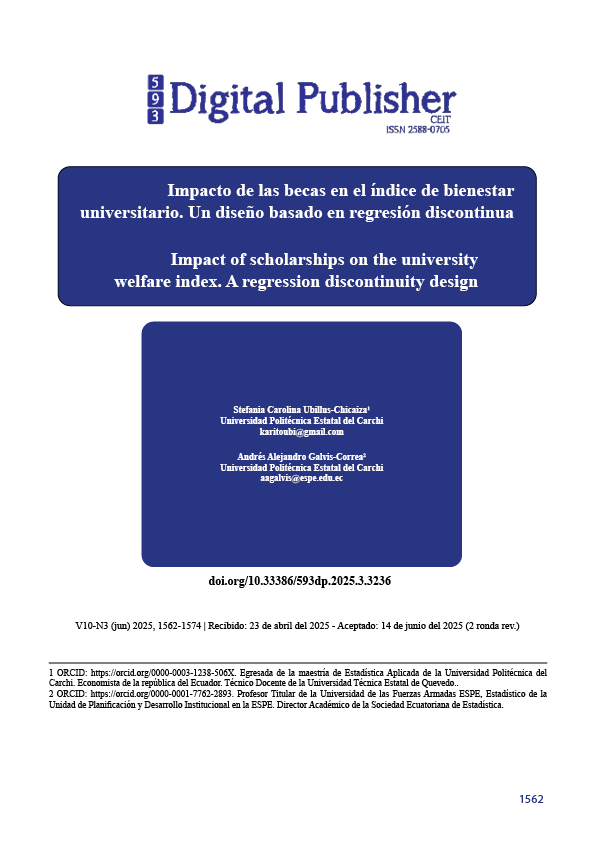Impact of scholarships on the university welfare index. A regression discontinuity design
Main Article Content
Abstract
The implementation of educational policies in higher education in institutional programmes plays an important role in academic development as well as in the index of university well-being by increasing the likelihood of students' permanence.
The discontinuous regression being a quasi-experimental design is positioned as an essential tool in the evaluation of the impact of educational interventions, in the present research the experimental sample includes the observation of 6,119 students eligible for scholarships selected according to their academic averages, the Sharp model was used with a cut-off point of 17.10 that corresponds to the treatment group of students with average equal or higher than 17.10 who receive these scholarships and as a control group to students with average lower than 17.10 who do not receive scholarships.
Academic control variables are included, such as: campus, degree, level and mode of study (face-to-face or online), in order to control for possible bias factors. These variables are incorporated into the regression discontinuity model to ensure that the estimation of the impact of the scholarships is not biased by systematic differences between students.
The parameter estimates for the three inference methods are significant at 1%, the most important being the robust estimate that allows us to conclude that there is a significant impact of the scholarship or financial support on the university welfare index. This impact is positive and has a magnitude of 14.19 points on the IBE.
Downloads
Article Details

This work is licensed under a Creative Commons Attribution-NonCommercial-ShareAlike 4.0 International License.
1. Derechos de autor
Las obras que se publican en 593 Digital Publisher CEIT están sujetas a los siguientes términos:
1.1. 593 Digital Publisher CEIT, conserva los derechos patrimoniales (copyright) de las obras publicadas, favorece y permite la reutilización de las mismas bajo la licencia Licencia Creative Commons 4.0 de Reconocimiento-NoComercial-CompartirIgual 4.0, por lo cual se pueden copiar, usar, difundir, transmitir y exponer públicamente, siempre que:
1.1.a. Se cite la autoría y fuente original de su publicación (revista, editorial, URL).
1.1.b. No se usen para fines comerciales u onerosos.
1.1.c. Se mencione la existencia y especificaciones de esta licencia de uso.
References
Angrist, JD y Lavy, V. (1999). Using Maimonides’ rule to estimate the effect of class size on scholastic achievement. Quarterly Journal of Economics, 114(2), 533–575. https://doi.org/10.1162/003355399556061
Cattaneo, MD, Jansson, M., y Ma, X. (2018). Manipulation testing based on density discontinuity. Stata Journal, 18(1), 234–261. https://doi.org/10.1177/1536867X1801800115
Cattaneo, MD, Idrobo, y Titiunik, R. (2019). A practical introduction to regression discontinuity designs: Foundations. Cambridge University Press. https://doi.org/10.1017/9781108684606
Cattaneo, MD, y Titiunik, R. (2022). Regression discontinuity designs in social sciences: A survey of recent developments. Annual Review of Economics, 14, 821–851. http://dx.doi.org/10.1146/annurev-economics-051520-021409
Calonico, S, Cattaneo, MD, y Titiunik, R. (2014). Robust nonparametric confidence intervals for regression-discontinuity designs. Econometrica, 82(6), 2295–2326. https://doi.org/10.3982/ECTA11757
Cordero, JM, Cristóbal, V, y Santín, D. (2018). Causal inference on education policies: A survey of empirical studies using PISA, TIMSS and PIRLS. Journal of Economic https://doi.org/10.1111/joes.12217
Clark, D, y Martorell, P. (2014). The signaling value of a high school diploma. Journal of Political Economy, 122(2), 282–318. https://doi.org/10.1086/675238
De Wit, H, y Altbach, P. G. (2021). Internationalization in higher education: Global trends and recommendations for its future. Policy Reviews in Higher Education, 5(1), 30–47. https://doi.org/10.1080/23322969.2020.1820898
Díaz Barrios, J, y Schlesinger Díaz, MW (2003). Ejecución de la política de formación del personal académico de La Universidad del Zulia durante la década de los noventa. Caso: Beca-sueldo. Opción, 19 (41), 140-157. https://ve.scielo.org/scielo.php?pid=S1012-15872003000200007&script=sci_abstract
Fan, J, y Gijbels, I. (1996). Local polynomial modelling and its applications. Chapman and https://doi.org/10.1201/9780203748725
Frölich, M. y Sperlich, S. (2019). Evaluación de impacto: Efectos del tratamiento y análisis causal. ISBN de libro electrónico:1108617778
Goodman, J, Hurwitz, M, y Smith, J. (2017). Access to 4-year public colleges and degree completion. Journal of Labor Economics, 35(3), 829–867. https://doi.org/10.1086/690818
Hahn, J., Todd, P, y Van Der Klaauw, W. (2001). Identification and estimation of treatment effects with a regression-discontinuity design. Econometrica, 69(1), 201–209. https://doi.org/10.1111/1468-0262.00183
Hernández-Medina, P, y Ramírez-Torres, G. (2022). Evaluación de impacto del financiamiento educativo en la deserción y la graduación: un análisis de regresiones discontinuas. Revista Iberoamericana de Educación Superior, XIII (37), 63-82. https://doi.org/10.22201/iisue.20072872e.2022.37.1304
Imbens, GW, y Lemieux, T. (2008). Regression discontinuity designs: A guide to practice. Journal of Econometrics, 142(2), 615–635. https://doi.org/10.1016/j.jeconom.2007.05.001
Imbens, G, y Kalyanaraman, K. (2012). Optimal bandwidth choice for the regression discontinuity estimator. Review of Economic Studies, 79(3), 933–959. https://doi.org/10.1093/restud/rdr043
Imbens, GW, y Rubin, D. B. (2015). Causal inference in statistics, social, and biomedical sciences: An introduction. Cambridge University Press. https://doi.org/10.1017/CBO9781139025751
Lee, DS, y Lemieux, T. (2010). Regression discontinuity designs in economics. Journal of Economic Literature, 48(2), 281–355. https://doi.org/10.1257/jel.48.2.281
Martínez Mendoza, E, y Martínez Mendoza, R. (2013). Análisis del efecto de las becas económicas en el rendimiento escolar en una institución de nivel medio superior. Investigación y Ciencia, 21 (59), 41-47. https://doi.org/10.33064/iycuaa2013593985
McCrary, J. (2008). Manipulation of the running variable in the regression discontinuity design: A density test. Journal of Econometrics, 142(2), 698–714. https://doi.org/10.1016/j.jeconom.2007.05.005
Ponce, J. (2023). Los primeros pasos: políticas para el desarrollo infantil y la educación en América Latina. FLACSO Ecuador. https://doi.org/10.46546/2023-44atrio
Ross, PM, Scanes, E. y Locke, W. (2024). Stress adaptation and resilience of academics in higher education. Asia Pacific Education Review, 25, 829–849. https://doi.org/10.1007/s12564-023-09829-1
Rubin, D. B. (1974). Estimating causal effects of treatments in randomized and nonrandomized studies. Journal of Educational Psychology, 66(5), 688–701. https://doi.org/10.1037/h0037350
Thistlethwaite, D. L y Campbell, DT. (1960). Regression-discontinuity analysis: An alternative to the ex post facto experiment. Journal of Educational Psychology, 51(6), 309–317. https://doi.org/10.1037/h0044319
Van Der Klaauw, Wilbert (2002). “Estimating the effect of financial aid offers on college enrollment: a regression -discontinuity approach”, International Economic Review, vol. 43, núm. 4, pp. 1249-1287, https://doi.org/10.1111/1468-2354.t01-1-00055
Villamizar, Villegas, M, Pinzon Puerto, F. A., y Ruiz‐Sanchez, M. A. (2022). A comprehensive history of regression discontinuity designs: An empirical survey of the last 60 years. Journal of Economic Surveys, 36(4), 1130-1178. https://doi.org/10.1111/joes.12461
Wray, S. y Kinman, G. (2020). The psychosocial hazards of academic work: An analysis of trends. Studies in Higher Education, 47(4), 771–782. https://doi.org/10.1080/03075079.2020.1793934



